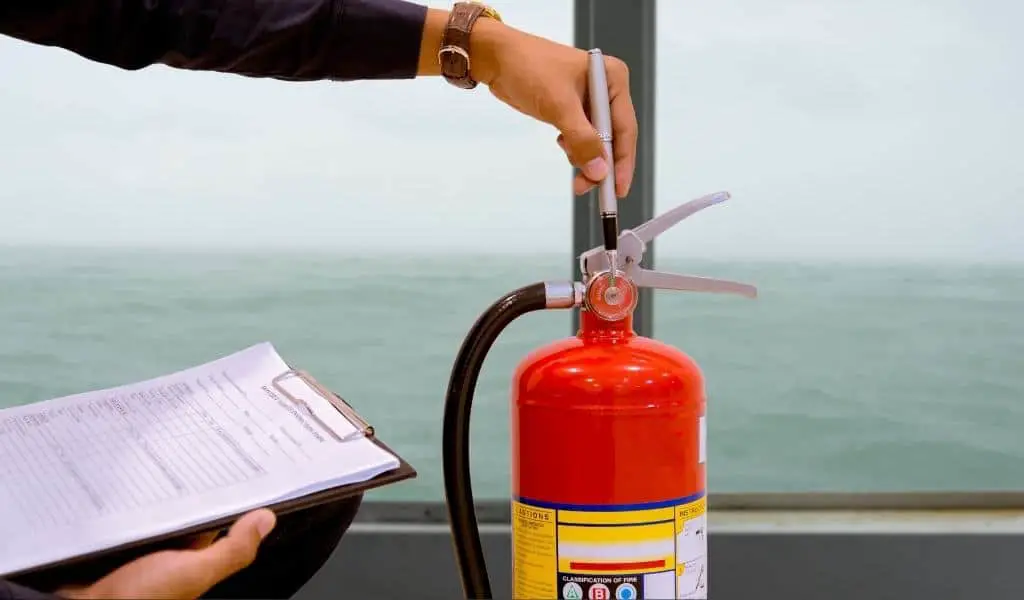Imagine picking up a fire extinguisher during an emergency on your boat only to find it’s empty or not in working condition. None of us want to find ourselves in this dangerous situation. Wouldn’t it be nice if there was a simple way to know if your fire extinguisher was in working order. I asked several experts, including the Coast Guard, how long a fire extinguisher lasts, and the answers I received were surprising.
Fire extinguishers do not last forever. Depending on the type, they should have a usable life of 6 to 12 years. However, the expiration date is not printed on most extinguishers, so it is difficult to know when they should be replaced. Fire extinguishers must be inspected routinely to confirm they are in good condition and have an acceptable pressure charge. If you follow these simple rules, your fire extinguisher should be ready to go if you have a fire emergency on your boat.
With such vague and confusing safety guidelines, you may be left wondering how can you know that your boat’s fire extinguisher is in good working order. In this article, I explain what I learned about inspecting your fire extinguisher and how to know when it should be replaced or refilled.
Do Fire Extinguishers Expire?
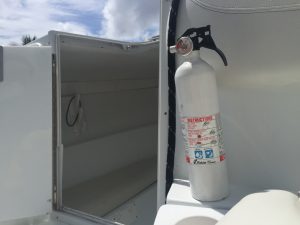
While the contents inside the fire extinguisher typically don’t ‘expire’ per se, its ability to operate properly is affected by a number of factors such as loss of charge, damage, and corrosion.
Most fire extinguishers do not come with a printed expiration date on it. This makes it difficult to know when your boat’s fire extinguisher should be replaced.
So, the short answer is that fire extinguishers do expire. However, you’re not likely to find a specific date printed on the extinguisher itself to track.
Read the manual that comes with your fire extinguisher to find the manufacturer’s replacement guidelines. Most disposable units are good for 12 years. Add this time to the date you purchased it, and write this date on the cylinder – “Replace Before MM-DD-YY” with a permanent marker.
Other Factors Affecting Service Life
Further complicating matters is that there are a number of external factors, such as rust and corrosion and wear and tear to tubing, that can impact a fire extinguisher’s ability to operate properly. It’s possible that your fire extinguisher is within it’s usable life, but is not fit for duty because it is poor condition. Read below for how to inspect your device.
Another caveat is fire extinguishers may become expired due to obsolete technology. For example, extinguishers with 4B, 6B, 8B, 12B, and 16B fire ratings and soda acid extinguishers are no longer valid because the chemicals used are not considered safe or effective. As a result, these units should be removed from your vessel and not used.
You should also consider any fire extinguisher expired if it was made by a manufacturer who’s no longer in business. Companies on this list include General Fire Extinguisher Company, Fyr-Fyter, Power-Pak, Norris, and RC Industries.
Which Extinguisher is Best?
If you’re looking for a reliable extinguisher for your small vessel, I have previously purchased the First Alert Marine Fire Extinguisher.
This extinguisher is suitable for fires rated 1-A: 10-B: C.
The letter relates to the fire group and the number is the size of fire it’s suitable for. The groups are:
- A – Ordinary combustibles such as wood, cloth, and paper.
- B – Flammable liquids such as gasoline, oil, and oil-based paint.
- C – Energized electrical equipment, including wiring, fuse boxes, circuit breakers, machinery and appliances.
- D – Combustible metals such as magnesium or sodium.
Rechargeable Verses Disposable Boating Fire Extinguishers
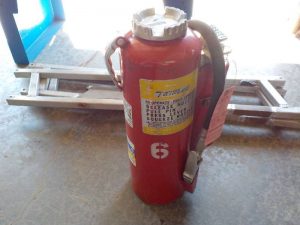
Fire extinguishers can be either disposable or rechargeable. You’ll need to know which you have on your boat in order to properly maintain and service it.
• Rechargeable Extinguishers
If your extinguisher is rechargeable, you’ll notice that it has a removable metal head as shown in the photograph. With most designs, you’ll also see a gauge with “recharge” and “overcharged” in color-coded red areas, and a separate green area in the center denoting the extinguisher is charged and ready to go.
Standards by the National Fire Protection Association state that rechargeable extinguishers must be recharged at least every six years.
You’ll want to put your rechargeable extinguisher on your monthly safety check list. If you find the needle is in the recharge or overcharged areas, take it to be serviced immediately.
Check your user’s manual for warranty information if it needs to be recharged prematurely. Most rechargeable extinguisher manufacturers offer a warranty; Kidde, for example, offers a six-year warranty on their rechargeable fire extinguishers.
• Disposable Extinguishers
Instead of a metal head, you’ll notice that disposable fire extinguishers have a plastic head. The gauge will read “full/empty.” Most all designs will indicate “full” in a color-coded green zone and “empty” in a color-coded red zone.
Standards by the National Fire Protection Association state that disposable fire extinguishers must be replaced every 12 years. Your disposable fire extinguisher should also be on your monthly safety check list and be replaced immediately if the gauge reads empty. Twelve years is a long time for anything to sit on a boat, especially a critical piece of safety equipment.
Practical Tip #2: Every five years, I add a new fire extinguisher to my boat and keep the old one as a back up. This takes the uncertainty out of the equation about whether or not my boat has adequate fire protection. Given how inexpensive fire extinguishers have become, I think this is low cost way to make my boat safer.
When Should Your Boat’s Fire Extinguisher Be Replaced?
- The Charge Is in Red or There’s No Pressure
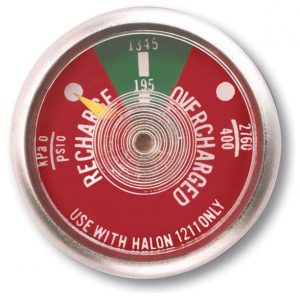
Whether you have a disposable or rechargeable fire extinguisher aboard your boat, neither will last forever. With the charge, you can always remember that green means it’s ready to go and red means it’s a no-go.
Older models without gauges can usually be tested for pressure with its pin. Press the pin in and release it. The extinguisher is considered pressurized if it immediately pops back out.
However, if you have an older model without a gauge, it’s a prudent investment to update so that you have a more easily measurable way of checking your fire extinguisher’s readiness at any given time.
- The Age of the Extinguisher
Many boaters let the lack of an expiration date on their fire safety equipment lull them into just assuming the extinguisher will always work. This is a mistake that puts the safety of your boat and it’s passengers at undue risk.
Most fire extinguisher manufacturers estimate that their products last between five and 15 years. Check the label or contact the manufacturer directly to determine the life expectancy of your particular model.
That said, few people remember to log when they purchased a fire extinguisher. If you bought your boat secondhand, then you likely didn’t think to ask the age of fire extinguishers.
On some models, the manufacturing date may be printed on the extinguisher’s cylinder body, label, under the plastic ring at the neck of the extinguisher, or under the extinguisher’s plastic boot. Of course, age, exposure to elements, and aesthetic repainting can affect the visibility of any printed date.
- When It Fails Your Monthly Safety Inspections
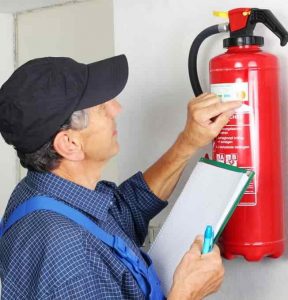
As mentioned above, you should add your boat’s fire extinguisher to your monthly safety inspections. In addition to the gauge reading, look at the hose, nozzle, handle, and locking pin to ensure all are in good working order. If not, have it serviced or replaced immediately.
It’s recommended to professionally service all models of fire extinguishers yearly as a preventative measure. You can use Google Local or the Yellow Pages to locate local fire safety specialist companies that service and repair fire extinguishers. Don’t forget to have maintenance and services added to the extinguisher’s inspection sticker.
- If It’s Been Used
Even if the gauges are still in the green, it was a slight accidental discharge, or you didn’t need to use much of the fire extinguisher, if it’s been discharged, then it needs to be serviced immediately to determine if it needs replacing or refilling.
Checklist on Inspecting Your Fire Extinguisher
The Coast Guard may inspect that you have a fire extinguisher, it’s the right kind, and that your gauges are green, but such inspections don’t cover if your fire extinguisher is actually in good working order. That will be on your shoulders as the boat’s owner. As you complete your monthly fire extinguisher inspections, be sure to check off the following:
- Give dry powder extinguishers a shake to prevent the contents from settling and getting impacted.
- Check that the inspection sticker is intact. If not, consider the extinguisher unknown and therefore expired.
- Inspect for signs of wear and tear, such as a loose handle, missing safety pin, or cracked hose.
- Inspect the nozzle for debris and clogging.
- Evaluate the fire extinguisher’s location – is it easily accessible, secure, and in close proximity to fire hazards?
- Is it time for professional service evaluation or maintenance?
Vessel Safety Check
Fire extinguishers are part of your annual vessel safety check, which is an inspection that awards vessels with an official decal to inform boating law enforcement, safety agencies, and insurers that the vessel was found to be in compliance with federal and state boating laws. By the way, obtaining this decal can also help lower the cost of your boat insurance.
The U.S. Coast Guard and others publish informational Vessel Safety Check manuals as a guide to the requirements and inspections. However, we haven’t come across any information in any of these manuals on fire extinguisher safety beyond the classification requirements.
Related Questions
Should I Test My Fire Extinguisher?
While discharging a little of the contents of your boat’s fire extinguisher sounds like a great way to ensure it works, this is actually the last thing you want to do. Remember, even if it’s a little or accidental, you’ll need to replace or recharge your extinguisher if it discharges.
Why? Discharging causes the pressure (PSI) to drop inside the tank, and that can cause the extinguisher not to work when you really do need it.
Practical Tip #3: Use your expired fire extinguisher as practice to learn how to use it. Showing your children and other adults the proper use of fire fighting equipment is extremely important. Remember to dispose of the unit after you’re done with the training exercise.
How Many Fire Extinguishers Do I Need?
You’ll want to look up the Coast Guard requirements for your specific vessel to determine how many and what class of fire extinguisher you’ll need.
It’s highly recommended to plus that number up, however. The discharge duration for portables is short, and most vessels are subject to some major fire risks. It’s always better to be more prepared than necessary than end up watching your costly vessel go up in flames.
You may also want to consider an engine compartment automatic fire suppression system as part of your fire prevention and safety strategy for your vessel. It’s a bit pricey, but it’s cheaper than engine and boat replacement if a major fire breaks out. And, the price is often offset by lower insurance premiums.
In conclusion, your boat is a major investment, right? As such, complacency has no place in your safety measures. Fire safety isn’t just having the right number and type of extinguishers for regulatory inspections. It’s you proactively ensuring they’ll work properly when you need them. National Fire Protection Association regulations state that your fire extinguishers should be inspected at least yearly by a certified technician and professionally pressure tested at least every five years. In the meantime, you should be doing your own fire equipment safety checks on your extinguishers monthly.

